Coleus is unusual in that it’s a tender perennial with almost no interest from its flowers. The impact of coleus lies almost entirely in its leaves, with a vibrant array of colour from each different variety that brightens up your garden long before, and after, everything else is flowering.
In this guide, we’re going to talk about some of the complicated history of coleus plants, as well as share the ultimate guide to growing coleus, from how to grow coleus, to propagation tips, and cultivation tricks.
More...
Coleus Plant Details
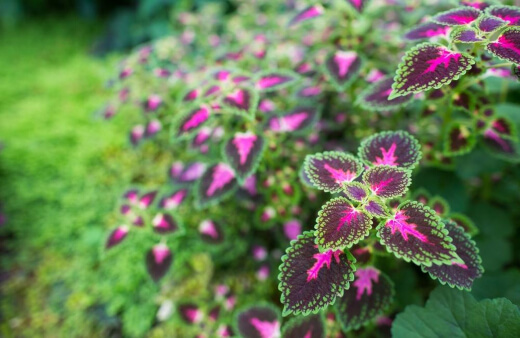
Coleus scutellarioides, despite being called poor man’s croton, and painted nettle, are in fact a mint (Lamiaceae). Their slightly disparaging titles come from their vibrant but unpredictable leaf patterns, which, while mostly red and acid yellow, are very easily affected by cross-pollination with other coleus plants.
Despite their challenges though, these ornamental mints are a great way to add a splash of colour to your garden and play with more contemporary tub and basket arrangements too.
This plant is classed as a tender perennial, but for the vast majority of Australian gardeners, they won’t need any protection and come back bigger and better the following year.
Coleus Natural Habitat
Coleus is native to Southeast Asia but spread to Australia where they grow wild around the warmer parts of the country.
They like moist, well-drained soil and can grow as tall as 2m once they are allowed to establish, but taller varieties tend to be leggy and are best pruned to maintain a good shape in cultivation.
What’s fascinating about it though is that while they are from warm climates and grow wild in full sun, they actually develop better as plants with some afternoon shade.
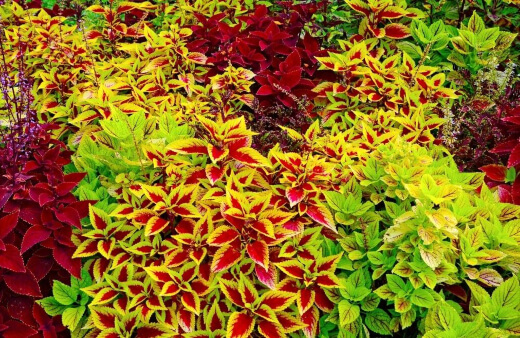
Coleus Taxonomy Explained
Coleus has a contrived and heavily contested taxonomy (the grouping of species) but finally appears to have its own settled genus. Despite having the genus Coleus removed, it always retained that title as its common name, so thankfully there is no confusion (visually) over what classes as a coleus.
- Coleus was first defined as its own genus in 1790 because, despite similarities in the leaf structure, roots, and habitats, its stamens were notably different to the Plectranthus genus it was previously part of.
- Then in 1962, J.K.Morton decided that the four fused stamens thought to be unique to Coleus were in fact more widespread in Plectranthus than previously thought, so grouped them back in as part of Plectranthus.
- In 2004, following DNA testing, Plectranthus, while baring the main ancestor to all these species, was in fact the umbrella for two very general subgenus – now defined as Coleus and Solenostemon in one half, and the now thinned down Plectranthus in the other.
- In 2018, Coleus became its own species, under Lamiaceae (mint), still containing Solenostemon, but distinct from Plectranthus.
So over the course of 230 years, this plant has been one of the most contested species in horticulture, and even with DNA testing, its relationships are still confused.
But, importantly, as we move into our list of the best Coleus to grow in Australia below, we can include Solenostemon (for now!)
9 Best Coleus Varieties to Grow in Australia
1. Coleus Trailing PlumTrailing plum is part of the Solenostemon genus within the wider coleus classification, but I adore this plant. Its delicate but vibrant leaves spread out from their centre more than most coleus, developing dozens of leaves per stem. They’re not quite trailing plants though, despite their name, but do provide an exquisite froth at the edge of a raised bed that sets off green spring foliage with a precise beauty. | 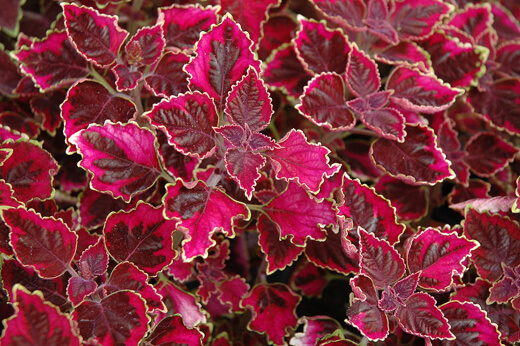 Source: plants.chaletnursery.com/ |
2. Coleus Kiwi FernAnother Solenostemon, the Kiwi Fern is an incredible plant that looks more like a coral than a plant, with vivid reds, greens and creamy edges to their leaves, they wouldn’t look out of place in a coastal garden. I’m very much inland, so I don’t benefit from the coastal relationship, but kiwi ferns make great leggy centrepieces to container planting arrangements. | 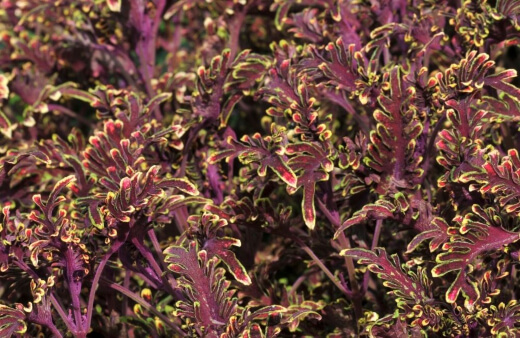 |
3. Coleus Rustic OrangeColeus Rustic Orange is truer to the base plants of the Coleus genus, with subtler tones that make a single bold statement. In this case, creating a warm, fiery sepia border edging. Coleus Rustic Orange make perfect border plants, but I like the statement they make by themselves in a pot. They grow into perfect domes of russet leaves, which is a surprisingly hard colour to find in nature. | 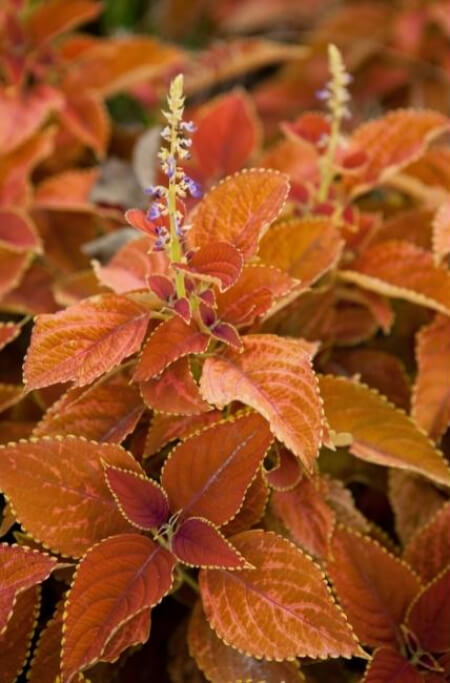 |
4. Coleus Black DragonBlack Dragon Coleus comes with a few caveats, as it is a standard name for a range of coleus, rather than a single defined plant. The colour of the black dragon is always uniform though, with edges to the leaves so purple that they look black in most lights and vivid stripes of magenta down the centre. The leaf shape is where the variation lies, so if you like control in your garden there are other dark-leaved coleus available, but the colour of black dragon coleus is unique. | 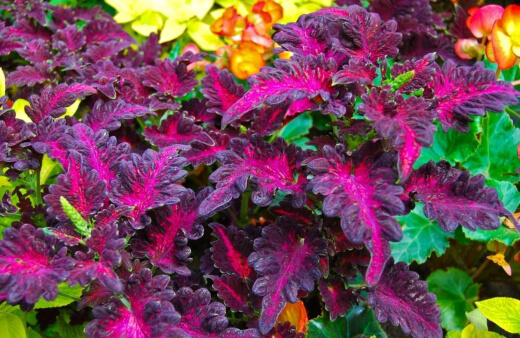 |
5. Coleus Big Red JudyBig Red Judy made this list mostly because of its brilliant name. There’s a fashion for ‘white gardens’ now, where gardeners attempt to tone down planting to create tranquil spaces with gentle whites. Big Red Judy would not work at all for that, but if you want to buck the trend and lean into the brash, harsh reds of true coleus, then this is a perfect cultivar, ready to make a serious impact. | 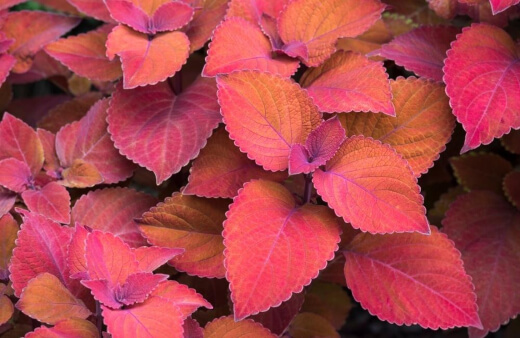 |
6. Coleus Wizard JadeWizard Jade is another Solenostemon within the Coleus genus, but what’s really special about Wizard Jade (and other Wizard coleuses) is that they trail. Wizard coleus are perfect for hanging baskets, trailing over the edge, and creating spheres of colour, but they will need watering almost every day in baskets to stop them from drying out. | 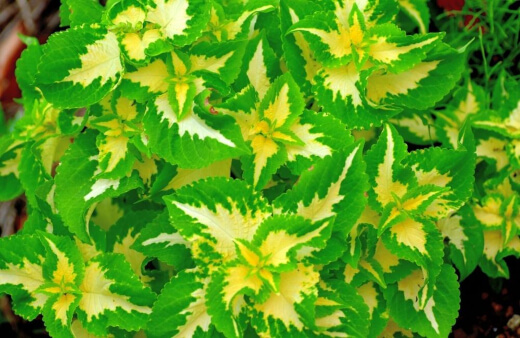 |
7. Coleus Mosaic FairwayWhen the botanists hybridised the Fairway Mosaic coleus, they must have had a bit of a fright. Most plants with these mosaic markings have harmless viruses bred into them to create interesting variegations (tulip mosaic virus being the most famous), but Fairway mosaic is just naturally predisposed to these magical markings. | 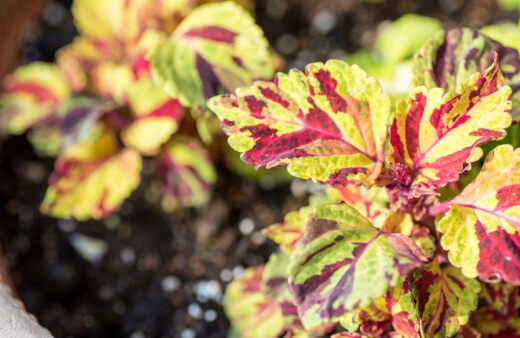 |
8. Coleus Wizard Velvet RedColeus fade after flowering, so the later you can get coleus to flower, and the more regularly you deadhead their flowers, the longer you’ll have their impact in the garden. As well as the ability to trail, coleus wizard velvet red is bred to be late-flowering, which extends the season of impact for their dazzling red foliage. |  |
9. Coleus Burgundy RufflesBurgundy Ruffles Coleus has a very similar leaf to Kiwi Fern, but slightly less extreme. That doesn’t make it any less impactful though, and Burgundy Ruffles is one of the tallest varieties you can grow, and in perfect conditions can reach over 1.5m tall in a single season. Their leaves vary hugely depending on their light exposure, so planting them in full sun will give you more variegation but duller colours, while planting in part shade will give you brighter plants that don’t grow quite as tall. | 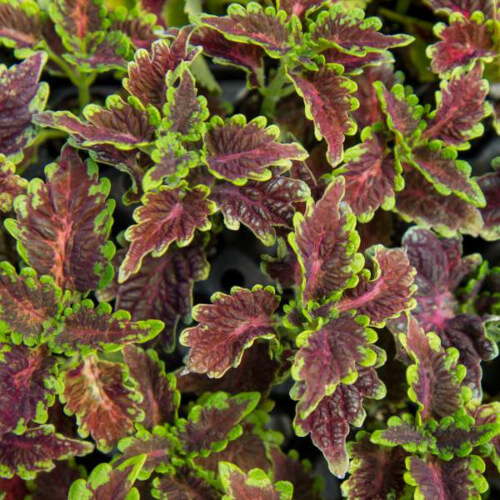 Source: ncfarmsinc.com |
1. Coleus Trailing Plum

Source: plants.chaletnursery.com/
Trailing Plum is part of the Solenostemon genus within the wider coleus classification, but I adore this plant. Its delicate but vibrant leaves spread out from their centre more than most coleus, developing dozens of leaves per stem.
They’re not quite trailing plants though, despite their name, but do provide an exquisite froth at the edge of a raised bed that sets off green spring foliage with a precise beauty.


Get Your Free Guide:
Master Growing Australian Natives eBook
A Must Have Complete Guide for Every Australian Garden
Get Your Free Guide:
Master Growing Australian Natives eBook
A Must Have Complete Guide for Every Australian Garden
2. Coleus Kiwi Fern

Another Solenostemon, the Kiwi Fern is an incredible plant that looks more like a coral than a plant, with vivid reds, greens and creamy edges to their leaves, they wouldn’t look out of place in a coastal garden.
I’m very much inland, so I don’t benefit from the coastal relationship, but kiwi ferns make great leggy centrepieces to container planting arrangements.
3. Coleus Rustic Orange

Rustic Orange is truer to the base plants of the Coleus genus, with subtler tones that make a single bold statement. In this case, creating a warm, fiery sepia border edging.
Rustic Orange coleus make perfect border plants, but I like the statement they make by themselves in a pot. They grow into perfect domes of russet leaves, which is a surprisingly hard colour to find in nature.
4. Coleus Black Dragon

Black Dragon Coleus comes with a few caveats, as it is a standard name for a range of coleus, rather than a single defined plant. The colour of the black dragon is always uniform though, with edges to the leaves so purple that they look black in most lights and vivid stripes of magenta down the centre.
The leaf shape is where the variation lies, so if you like control in your garden there are other dark-leaved coleus available, but the colour of black dragon coleus is unique.
5. Coleus Big Red Judy

Big Red Judy made this list mostly because of its brilliant name. There’s a fashion for ‘white gardens’ now, where gardeners attempt to tone down planting to create tranquil spaces with gentle whites.
Big Red Judy would not work at all for that, but if you want to buck the trend and lean into the brash, harsh reds of true coleus, then this is a perfect cultivar, ready to make a serious impact.
6. Coleus Wizard Jade

Wizard Jade is another Solenostemon within the Coleus genus, but what’s really special about Wizard Jade (and other Wizard coleuses) is that they trail.
Wizard coleus are perfect for hanging baskets, trailing over the edge, and creating spheres of colour, but they will need watering almost every day in baskets to stop them from drying out.
7. Coleus Mosaic Fairway

When the botanists hybridised the Fairway Mosaic coleus, they must have had a bit of a fright. Most plants with these mosaic markings have harmless viruses bred into them to create interesting variegations (tulip mosaic virus being the most famous), but Fairway mosaic is just naturally predisposed to these magical markings.
8. Coleus Wizard Velvet Red

Coleus fade after flowering, so the later you can get coleus to flower, and the more regularly you deadhead their flowers, the longer you’ll have their impact in the garden.
As well as the ability to trail, coleus wizard velvet red is bred to be late-flowering, which extends the season of impact for their dazzling red foliage.
9. Coleus Burgundy Ruffles

Source: ncfarmsinc.com
Burgundy Ruffles Coleus has a very similar leaf to Kiwi Fern, but slightly less extreme. That doesn’t make it any less impactful though, and Burgundy Ruffles is one of the tallest varieties you can grow, and in perfect conditions can reach over 1.5m tall in a single season.
Their leaves vary hugely depending on their light exposure, so planting them in full sun will give you more variegation but duller colours, while planting in part shade will give you brighter plants that don’t grow quite as tall.
How to Grow Coleus in Australia

Coleus can be grown as a houseplant, hence its common name (poor man’s croton), but they will nearly always prefer outdoor environments in Australia, as they are as close to their natural habitat in your garden as they can be, so are a great way to bring native species into the garden.
Growing Coleus Outdoors
Coleus can be grown in the ground in most of Australia, but if you live anywhere with sandy or poor soil make sure to add a general soil improver to the planting hole, or dig manure through before planting coleus to improve water retention.
It might like hot weather, but they also enjoy heavy rain, so be mindful to prevent droughts around their roots. Find a bright, sunny spot with some shade from the midday sun, where you’ll be able to see them.
Coleus look incredible all season, but in late spring they are full of vigour so it’s worth planting coleus somewhere prominent to make the most of the early season colour.
How to Grow Coleus in Containers
Coleus is slow to spread, unlike their relatives in the mint family, so there’s no need to contain them in any way. But most gardeners prefer to keep coleus as ornamental plants, and raising them up in containers is a great way to showcase the rich variety of colour and form that this plant offer.
If planting coleus in containers, make sure they have a good moisture retentive compost mix, but with lots of drainages added at the bottom of the pot. This ensures they are kept moist, but won’t stand in water.
Water containers 1-2 times per week, particularly in summer, and if there is any risk of frost or temperatures below 5°C, move the pots indoors or into the greenhouse. Or at the very least, up against the house where they benefit from lost heat.
Tip: Plants in pots are more prone to frost and cold than plants in the ground, where the soil helps to regulate temperatures and insulate roots.
Coleus Propagation
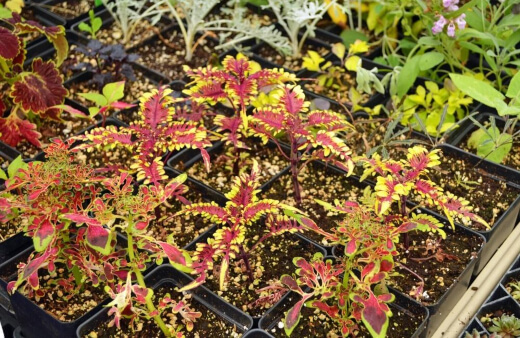
Coleus grows from seed and cuttings, even in the coldest climates, and in most of Australia where they are perennial plants, they can be propagated from division.
In the sections below we’ll guide you through how to make new coleus plants yourself, and save money at the garden centre.
Propagating Coleus from Seed
Coleus is really easy to sow from seed. I’ll run through a quick step-by-step of the best way to sow coleus below, but you can cut corners. We’ve tried all sorts of methods, and provided they get enough sun, coleus germinates at a nearly 90% success rate in any low nutrient planting medium.
We’ve sown coleus in seed compost, sieved garden compost, coir compost, and even topsoil (though topsoil damped off seedlings quite badly so is best avoided), but the most reliable method to sow coleus is this:
- Fill a seed tray ¾ full with peat-free seed compost (ideally a seed module tray as germination will be near 100% and modules make it easier to pot on).
- Thinly sow coleus on the surface of the soil, and cover lightly with vermiculite (vermiculite has enough nutrients to support seedlings without shocking them).
- Water them well, and leave them anywhere with temperatures above 15°C
- Seedlings should appear within 14 days, then just leave them to grow until they have 2-3 sets of true leaves, and roots poking out of the base of their module.
- This plant doesn’t like to be restricted, so pot them on as soon as you see roots appear underneath. At this point, you can either plant them directly in the garden or grow them in small pots for a while to create stronger plants before they hit the garden.
How to Propagate Coleus from Cuttings
Cuttings are incredibly easy to take, but whatever climate you live in, they are best grown indoors.
Because coleus has regular new growth, they have cutting material available almost all spring, summer and autumn provided the parent plant has enough material to recover from.
- Start by cleaning your knife. This plant is prone to infection so clean tools are essential.
- Find a strong set of leaves on a 10-12cm stem, cut it just above a set of leaves (this is where the original plant will bush out from)
- Strip the stem by cutting off every leaf, other than the top set of leaves
- Place the cutting in water, and leave it to the root.
- After 1 week you should start to see small white roots appear at the base.
- When the roots are around 5cm long, carefully place your cutting in sieved compost, and wait for roots to appear at the bottom of the pot.
Propagating Coleus from Division
While division strictly means separating a single plant from its main root, that’s not quite how Coleus grows, but the same basic method applies.
When you have mature, 2-3-year-old coleus in the garden, it will have either self-seeded or spread out around itself. Carefully find the base of each plant, and those plants can be gently dug up, and moved to another part of the garden.
Cut back any top growth when you move the plant, which forces the roots to kick back into action to help the tops recover. Divide clumps of coleus in spring, so they are ready to burst back into life.
Caring for Coleus

Coleus like rich, water-retentive soil with good drainage, and should never be allowed to dry out, or sit in standing water. Other than finding that balance of watering, this plant is incredibly simple to care for.
What Fertiliser to Use
Provided they are planted in good soil, or organic manure is dug through prior to planting coleus, they won’t need any fertiliser, but for coleus in pots with basic compost (make your own compost using the best compost bins in our product review), they do benefit from slow-release fertiliser capsules to give them a general boost without focussing on any one part of the plant in particular.
Watering Coleus
This plant needs regular water, and should never be allowed to dry out completely. If the surface of the soil is dry, or the water is running straight out of the pot, stand your container in water for half an hour until the surface looks moist.
This revives the soil and opens up the structure so it can receive water after a period of drought.
Coleus Winter Care
If you live in a cold part of Australia, coleus is generally referred to as annuals, but it's important to remember that these plants are perennial, and as such, want to come back year after year.
If you’ve got them planted in the border, dig it up in late autumn, cut back 75% of the top growth, and place it in the greenhouse, or even indoors to protect it from frost.
For milder parts of the country, just mulching coleus around the base of the plant will be enough to keep the plant alive until next spring. (See the best types of mulches and learn when and how to use them here.)
Coleus Common Pests and Diseases
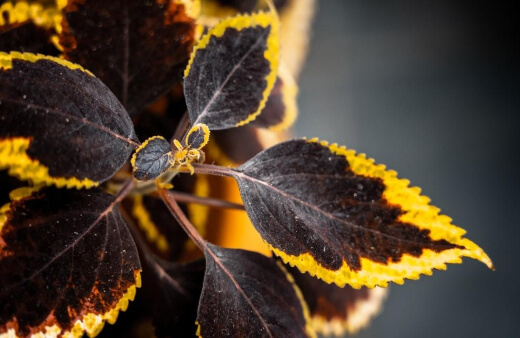
Coleus doesn’t generally suffer pests in the garden, other than slugs and thrips.
Slugs
Slugs like coleus because they are an easily accessible food source, but not particularly tasty for them, so if you have a general barrier of eggshells that’s usually enough to deter them.
Thrips
Thrips on the other hand will land on any plant they can find without discrimination, and while their eggs and larvae won’t harm coleus roots, they are carried of necrotic spot virus, which kills plants.
There is no cure, and most thrip preventions are ineffective, so maintaining a good ecosystem in the garden, including birds and ladybugs to eat the thrips is useful.
Necrotic Spot Virus
Necrotic spot virus is spread to coleus by thrips. The virus is preventable but not treatable. If you see brown or yellow spots on leaves this is the formation of dead tissue (necrosis).
Necrosis in plants will just spread, so you need to cut off any leaves and stems that have any signs of the virus and bin them.
If you don’t catch it early enough, the entire plant will need to be dug out and binned before it spreads to other plants.
Downy mildew
The only other common problem for coleus is mildew. Downy mildew is a fungus, with spores spread by wind, insects, tools, etc. Mildew’s development is sped up by humidity and poor air circulation, so to prevent it, you can thin out your coleus throughout the year so there is good airflow around the leaves.
The treat downy mildew on coleus, a general-purpose organic fungicide is the best option. Neem oil works well for me, but there are other organic fungicides and home remedies that work well too.
Coleus Frequently Asked Questions
Does Coleus come back every year?
In most parts of Australia, Coleus comes back every year. While coleus that are over 3 years old can get leggy and begin to flop in warm climates, they can be cut back to 10cm above the ground and mulched.
This promotes vigorous new growth and should help your plant regain its neat bushy structure.
Does Coleus like sun or shade?
Coleus is naturally found in sunny locations across Southern Asia and Australia, but performs best in part shade. If you can find a warm spot in the garden, where your coleus are protected from the midday sun they will thrive with much brighter leaves than when they are planted in full sun.
Is Coleus a good houseplant?
Coleus is a great houseplant, but they prefer the outdoor life in Australia and can grow year-round in most of the country outside, provided there are no frosts.
If you choose to grow your coleus indoors, make sure it is well watered and kept somewhere warm but away from radiators or air conditioning.
Is Coleus a nettle?
Despite their common name of ‘painted nettle’, coleus is in fact a subspecies of mint, and not at all related to nettles. Their leaves have mildly serrated edges, which look very like nettles, but the significant difference is in the formation of new leaves which grow almost as florets in coleus.

Add a Splash of Vivid Color and Lush Foliage to Your Garden with Coleus
Coleus’ matt velvety leaves are one of the best things about spring in Australia, with vibrant colours before much of the rest of the garden begins to bloom.
They do need some careful attention to watering but as long as you don’t drown them, or dry them out, they’ll be happy enough. Now you know how to grow coleus in Australia, you’ll have spectacular borders and pots, full of coleus, so get planting.
Published on March 9, 2022 by Maisie Blevins
Last Updated on September 19, 2025





This is a fabulous forum for plant lovers. I am a reasonably experienced gardener but have learned tips and tricks from this site delivered in a very useful, easy to read and well-explained format.
Congratulations on a job well done.
Hi,
Thank you for the nice feedback.
All the best,
Gary Clarke